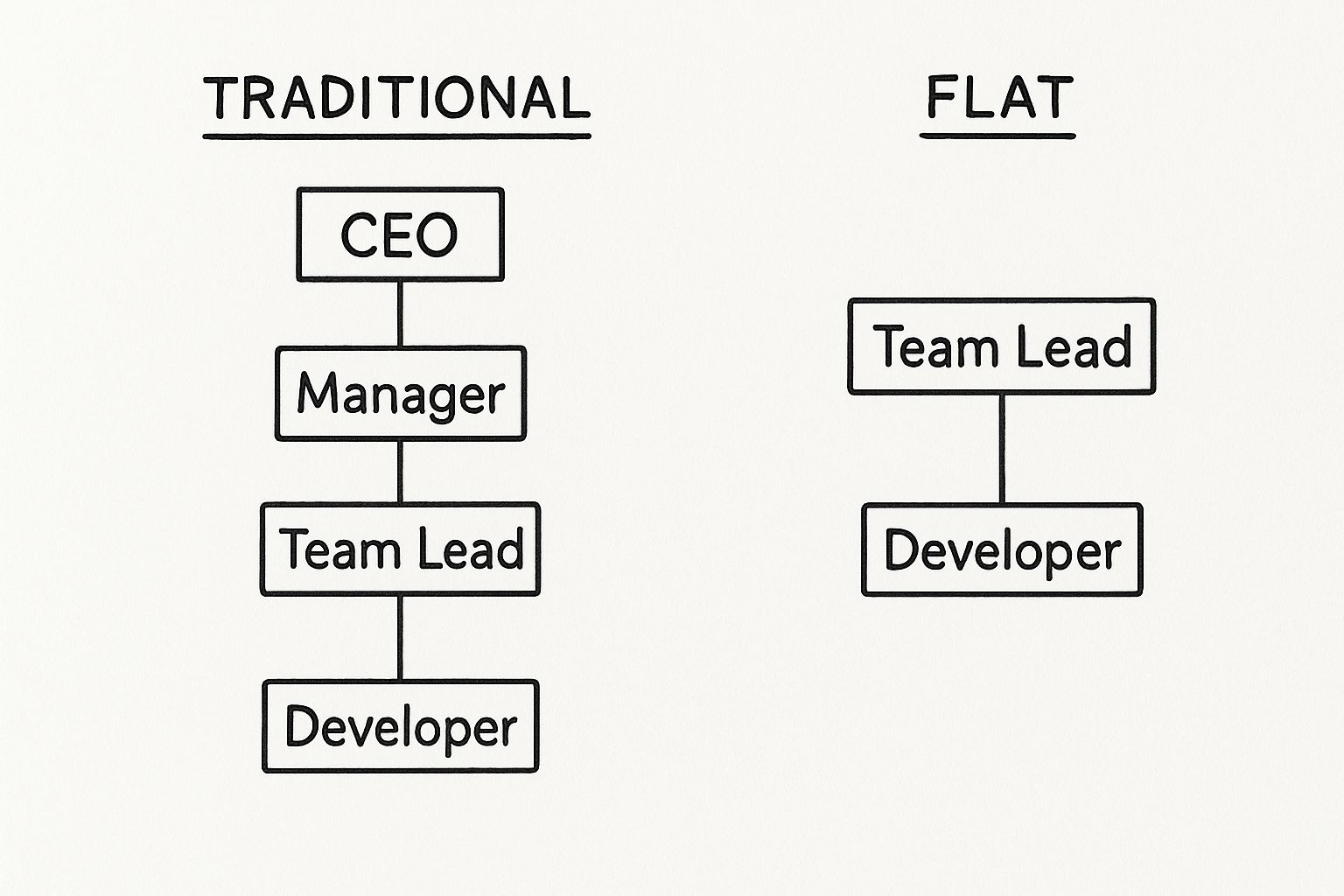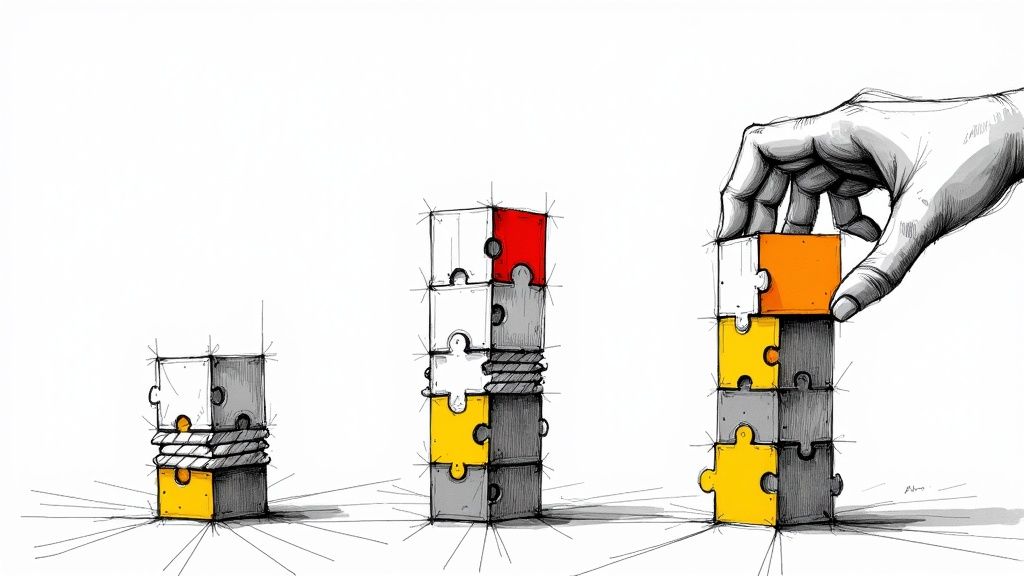Table of Contents
Why Most Development Teams Fail Before They Start
The Hidden Costs of Dysfunction
The Death Of Command-And-Control: How Teams Really Work Now
The Rise of Agile and Flat Structures
Embracing Decentralized Decision-Making
Anatomy Of Teams That Ship: What Actually Makes Them Different
The Importance of Team Structure
Key Roles and Their Interactions
Cross-Functional Teams That Actually Function
From Standups to Sprints: Collaboration in Action
The Power of Productive Conflict
The Agile Transformation: A Double-Edged Sword
Breaking The Wall: When Dev And Ops Actually Collaborate
The Foundation of True Collaboration
Building Bridges: Skills and Practices
Real-World Examples: DevOps in Action
Beyond Rebranding: Measuring Real Change
Distributed Teams That Don't Feel Distributed
The Power of Asynchronous Communication
Building Trust Through Transparency
Structured Frameworks for Distributed Success
Onboarding and Maintaining Code Quality
Your Team Structure Decision Framework
Diagnosing Your Current Situation
Designing a Structure That Fits
Why Most Development Teams Fail Before They Start
Imagine two startups. Same funding, similar products, equally talented developers. Six months later, one launches a killer product, the other is drowning in organizational chaos. What's the difference? Not coding prowess, but the software development team structure.
Choosing the right structure is paramount. A poor structure leads to burned-out developers, stifled creativity, and glacial progress. Communication breaks down, and simple features become month-long development nightmares. In contrast, a well-structured team is a well-oiled machine, efficiently transforming ideas into shipped products.
The Hidden Costs of Dysfunction
Picture a development team where information flows like a game of telephone. Requirements get garbled, priorities shift mysteriously, and developers build features nobody wants. This is a dysfunctional team structure in action. The costs are often hidden, but substantial: wasted time, demoralized developers, and a subpar product.
This screenshot from FullScale.io shows a variety of team structures:
Notice the range, from generalist teams to specialized groups. This illustrates the need to tailor the structure to the project. A one-size-fits-all approach rarely works. A small team on a simple project might thrive with a generalist structure, while a large, complex project might demand specialized teams.
The Importance of Structure
Effective team structures optimize resources and streamline communication. This is crucial in today's competitive market. The increasing demand for skilled developers makes efficient team management even more vital. The numbers tell the story. By 2025, the global shortage of software engineers is expected to hit 3.5 million positions. This highlights the need for efficient teams. Furthermore, 75% of business executives admit their projects are often doomed from the start because of inadequate team structures. Discover more insights.
Ready to drive more growth & achieve bigger impact?
Leverage my 25+ years of successes and failures to unlock your growth and achieve results you never thought possible.
Get StartedThis emphasizes a key point: even brilliant developers can’t succeed in a broken system. The right team structure is the foundation for successful products. The next sections will delve into the key elements of effective team organization and guide you in choosing the best structure for your needs.
The Death Of Command-And-Control: How Teams Really Work Now

Remember the old-school software development world? Rigid hierarchies. Top-down orders. Developers seen as coding machines. This command-and-control structure, once the standard, is fading fast. Why? The need for speed and flexibility in tech's ever-changing world. Companies stuck in these old ways struggle to find and keep good people.
The Rise of Agile and Flat Structures
Agile methodologies are a big part of this change. Traditional hierarchies, with their fixed roles and top-down responsibility, are giving way to flatter, more adaptable models. Agile teams thrive on cross-functional collaboration, allowing them to adjust quickly to new demands and creating a more energetic work environment. This shift often requires a real culture change within organizations. The very structure of software development teams has been reshaped, especially with Agile's rise. Traditional hierarchies are being replaced by models that breathe a little more. Learn more about Agile team structures.
Embracing Decentralized Decision-Making
This isn't just about flattening the org chart; it's about changing how teams work. Companies like Spotify, with their squad model, have pioneered new team setups. These models give developers more freedom and power to make decisions. No more architects dictating every single detail. Netflix also fosters a culture where developers contribute to architectural choices, blurring the lines between traditional roles.
From Silos to Collaboration
This change also affects information flow and accountability. Forget siloed teams working in isolation. The focus now is on collaborative, self-managing units. This builds shared responsibility and encourages proactive problem-solving. It's about creating an environment where talented individuals can truly work together, not just follow orders. This new approach demands a different kind of leadership, one that enables and empowers instead of directing and controlling. The changeover can be bumpy, but the payoff – more innovation and happier teams – is worth it. We'll explore what sets high-performing teams apart in the next section.
Anatomy Of Teams That Ship: What Actually Makes Them Different
What separates software development teams that consistently deliver from those constantly stuck in the planning phase? It’s not just about having skilled developers; it’s about strategically blending different skills and viewpoints. Think about high-performing teams at companies like GitHub and Slack. By examining their team dynamics and decision-making processes, we can understand why some teams adapt quickly while others struggle.
The Importance of Team Structure
A well-defined team structure is essential for software development. It clarifies individual roles, simplifies communication, and enables effective decision-making. This isn't about rigid hierarchies; it's about building an environment where everyone can excel and contribute meaningfully.
The infographic below illustrates the difference between traditional and flat organizational models for software development teams:

As you can see, flat structures minimize communication bottlenecks and give developers more autonomy. This leads to faster decisions and quicker adaptation to change. For a deeper dive into leadership within these structures, check out this resource on technical leadership skills.
Key Roles and Their Interactions
Successful teams have a balanced mix of roles. This often includes a blend of senior and junior developers, where senior developers mentor and guide, while juniors offer fresh perspectives. Finding the right balance is key for sustainable team growth.
- Tech Leads: These individuals guide the technical direction and ensure code quality. Think of them as the architects of the software.
- Developers (Front-end, Back-end, Full-stack): These are the builders, the ones who actually write the code that brings the software to life.
- QA Engineers: Quality Assurance engineers are the testers, making sure the software works as expected and is free of bugs.
- UX/UI Designers: They focus on the user interface and experience, making sure the software is both user-friendly and visually appealing.
- Product Owners/Managers: They define the product vision and roadmap, ensuring the team is building the right thing at the right time.
These roles need to interact effectively. Productive conflict, where team members challenge each other’s ideas to reach the best solutions, is encouraged. This is the opposite of dysfunctional teams, where disagreements become personal and stall progress.
Ready to drive more growth & achieve bigger impact?
Leverage my 25+ years of successes and failures to unlock your growth and achieve results you never thought possible.
Get StartedThe Often-Overlooked Roles
High-performing teams recognize the value of roles that may not be as prominent, but are just as crucial.
- Technical Writers: They create clear documentation, which reduces misunderstandings and saves development time. This is especially important for complex projects.
- DevOps Engineers: They bridge the gap between development and operations, enabling faster and more reliable deployments. They streamline the process of getting code into production.
These often-overlooked roles contribute significantly to a team's success. They ensure smooth workflows and minimize friction, allowing teams to deliver features quickly and efficiently.
To understand how these roles function and interact within different team structures, take a look at the comparison table below:
Core Team Roles and Responsibilities Comparison A detailed breakdown of essential roles in different team structures, showing responsibilities, ideal team ratios, and collaboration patterns.
| Role | Traditional Structure | Agile Structure | DevOps Structure | Key Responsibilities |
|---|---|---|---|---|
| Tech Lead | Manages developers, makes technical decisions | Facilitates technical discussions, mentors developers | Champions technical excellence, collaborates with Ops | Technical direction, code quality, mentoring |
| Developer | Follows instructions, codes assigned features | Works in sprints, collaborates closely with QA | Builds and deploys code, automates processes | Writing code, testing, debugging |
| QA Engineer | Tests at the end of development cycle | Tests throughout the sprint, provides continuous feedback | Integrates testing into the pipeline, focuses on automation | Testing, quality assurance |
| UX/UI Designer | Designs upfront, limited developer interaction | Works iteratively, collaborates with developers | Designs for usability and operability, participates in deployments | User interface and experience design |
| Product Owner/Manager | Defines requirements upfront, manages scope | Prioritizes backlog, collaborates with the team | Focuses on customer value, collaborates with Dev and Ops | Product vision, roadmap, prioritization |
| Technical Writer | Creates documentation after development | Creates documentation alongside development | Maintains living documentation, integrates with CI/CD | Documentation, knowledge sharing |
| DevOps Engineer | N/A | May exist in some teams | Automates infrastructure, manages deployments | Deployment pipeline, infrastructure automation |
This table highlights how responsibilities shift and collaboration patterns evolve across different team structures. Notice how the DevOps structure emphasizes shared responsibility and automation.
Ultimately, building a successful team comes down to understanding how these different roles interact and contribute to the shared goal of delivering great software.
Cross-Functional Teams That Actually Function

This screenshot from Atlassian highlights different aspects of Agile, a common framework for cross-functional teams. The emphasis on flexibility and collaboration reflects the core principles behind successful cross-functional software development teams. But these principles are often misunderstood, leading to teams that are "cross-functional" in name only.
Many companies talk about Agile, but often they're just rebranding existing, struggling teams. Truly cross-functional teams don't just share an office; they share ownership, responsibility, and a unified vision for the product. This shared understanding is key to navigating the complexities of modern software development. They succeed and fail together, building a sense of shared purpose. This section explores what a truly functional cross-functional team looks like in the real world.
From Standups to Sprints: Collaboration in Action
Effective cross-functional teams use tools like daily standups not just as status reports, but as chances to identify and solve problems together, in real-time. This prevents small issues from becoming major headaches. Similarly, sprint planning becomes a collaborative effort, fostering real commitment from everyone, not just a mandate from above.
For example, imagine a team working on a tough user interface challenge. In a truly cross-functional environment, developers, designers, and product managers work side-by-side from the very beginning of the design process. This collaborative approach ensures the final product is not only technically solid, but also user-friendly and aligned with the overall product vision. This gets rid of the constant back-and-forth common in siloed teams.
The Power of Productive Conflict
High-performing cross-functional teams welcome productive conflict. This isn't about personal attacks or bruised egos. It’s about building a space where people feel safe challenging each other's ideas constructively. This leads to stronger solutions and a deeper understanding of the problem. This is a major differentiator for successful teams. You might be interested in: How to Improve Team Culture
The Agile Transformation: A Double-Edged Sword
Moving to an Agile software development team structure can be a real game-changer, creating a rewarding experience for developers. But poorly implemented Agile transformations can become bureaucratic nightmares. Instead of streamlined processes, teams get stuck in endless meetings, slowing down progress and killing innovation.
The key is understanding the cultural shifts needed for Agile to truly work. It means moving beyond superficial changes to embrace real collaboration and shared ownership. This often means dealing with the messy middle of transitions, where old habits clash with new methods. It's about realizing that true Agile is more than a set of processes—it’s a change in mindset. This commitment to constant improvement sets effective Agile apart from expensive consulting theater. It's the difference between actual progress and just going through the motions. This requires a willingness to adapt and evolve, constantly refining processes and how the team communicates. This continuous evolution helps the team stay agile and responsive to the ever-shifting landscape of software development.
Breaking The Wall: When Dev And Ops Actually Collaborate
For years, the relationship between development and operations teams often felt like a frustrating game of telephone. Developers would build software, then toss it "over the wall" to operations. Operations would then have to figure out how to deploy and maintain it. This often led to a lot of finger-pointing and a real lack of shared responsibility. DevOps emerged as a way to fix this broken relationship, a philosophy and set of practices designed to bridge the gap. But actually making DevOps work requires more than just changing a team's name.
The Foundation of True Collaboration
Real DevOps collaboration needs a fundamental shift in how software development teams are structured, and how they think. It's about building a culture of shared ownership. Everyone is responsible for the entire software lifecycle – from the initial design all the way through to deployment and maintenance. This means developers need to understand the infrastructure side of things, and operations engineers need to start thinking like product builders. When building these cross-functional teams, it's helpful to look at the best practices from other collaborative fields, such as community management.
Building Bridges: Skills and Practices
So, how do we actually build these bridges between development and operations? A few key skills and practices can help:
- Automation: Automating repetitive tasks (like testing, deployment, and infrastructure management) frees up everyone to focus on more important, strategic work. It also reduces human error.
- Continuous Integration/Continuous Delivery (CI/CD): Think of CI/CD pipelines as automated highways for your code. They automate building, testing, and deploying, allowing for much faster and more frequent releases. Jenkins is a popular open-source automation server used in CI/CD pipelines.
- Infrastructure as Code: This means managing your infrastructure through code instead of manual processes. This makes everything more consistent and reproducible, and it makes collaboration much easier. Tools like Terraform enable Infrastructure as Code by providing a consistent CLI workflow to manage hundreds of cloud services.
- Monitoring and Feedback Loops: Real-time monitoring and feedback gives you crucial insights into how your application is performing and how users are interacting with it. This allows teams to proactively identify and fix problems.
Real-World Examples: DevOps in Action
Companies like Amazon and Google, masters of deploying software hundreds of times a day without major issues, offer great examples of DevOps in action. Their site reliability engineers (SREs) aren't just fixing problems; they're building resilient systems from the ground up, designed to withstand failures. These SREs are embedded within development teams, sharing their knowledge and working together from day one.
Beyond Rebranding: Measuring Real Change
Success in DevOps isn't about adopting new tools or changing a team name. It's about measurable improvement. So, what should you measure?
- Deployment Frequency: How often are you releasing new code to production?
- Lead Time for Changes: How long does it take for a code change to go from development to production?
- Mean Time to Recovery (MTTR): How long does it take to recover from a production failure?
- Change Failure Rate: What percentage of deployments cause problems?
To illustrate the tangible impact of transitioning to a DevOps structure, let's examine some key metrics. The following table compares traditional, siloed team structures with integrated DevOps structures.
Traditional vs DevOps Team Structure Impact
Comparison of key metrics showing the measurable differences between traditional siloed teams and integrated DevOps structures
| Metric | Traditional Teams | DevOps Teams | Improvement % | Business Impact |
|---|---|---|---|---|
| Deployment Frequency | Monthly | Daily | 3000% | Faster time to market |
| Lead Time for Changes | Weeks | Hours | 98% | Increased agility |
| Mean Time to Recovery (MTTR) | Days | Minutes | 99% | Improved customer satisfaction |
| Change Failure Rate | 15% | 5% | 67% | Reduced risk and cost |
Note: These figures are representative examples and can vary based on specific industry, company size, and implementation maturity.
As this table demonstrates, DevOps can lead to dramatic improvements across multiple areas. Faster deployments, quicker recovery times, and fewer failures translate directly to a better experience for your users and greater business value. If these numbers aren't improving, your DevOps initiative might just be an expensive rebranding exercise. Real DevOps is about changing how software gets built, not just what you call the team building it.
Distributed Teams That Don't Feel Distributed

Remote work has taught us something surprising: being in the same room doesn't guarantee great teamwork, and distance doesn't have to mean disconnection. In fact, some distributed development teams are shipping products faster and building stronger relationships than their office-based counterparts. So, what's their secret? It all comes down to the software development team structure.
The Power of Asynchronous Communication
One key ingredient is asynchronous communication. Instead of constant real-time meetings, these teams often use tools like Slack, project management platforms, and shared documents. This allows people to work when they're most focused, regardless of time zone, and helps avoid the fatigue of endless video calls. Think of it like email, but supercharged for project updates, code reviews, and quick questions. This creates space for deep, uninterrupted work.
Building Trust Through Transparency
Another critical piece is transparency. When you can't physically see your teammates, it's crucial to make everyone's work visible. This might involve using project management tools to track progress, regularly sharing code updates, and having open conversations about roadblocks. Companies like GitLab and Automattic, both successful remote-first organizations, heavily rely on public documentation and internal wikis. This open approach builds trust and helps everyone understand the overall strategy.
Structured Frameworks for Distributed Success
Successful distributed teams also embrace structure. They have clear processes for everything from onboarding new developers to conducting code reviews. These guidelines ensure consistency and prevent remote work from turning into a chaotic game of telephone. This is especially important for companies working across multiple locations. In fact, for distributed teams, which make up 78% of software engineering teams, structured frameworks improve code quality and speed up project completion. With the software market expected to hit USD 824 billion by 2025, adaptable and efficient team structures are more important than ever. Discover more insights about software development statistics.
Onboarding and Maintaining Code Quality
Remote onboarding requires a thoughtful approach. Successful companies create detailed onboarding documents, assign mentors, and encourage regular check-ins. This helps new hires feel welcome and become productive quickly. Similarly, maintaining high code quality with asynchronous reviews calls for clear coding standards, automated testing, and tools that facilitate collaborative reviews.
Building a thriving culture is essential for any distributed team. Explore strategies in this article about Remote Team Culture Mastery: Battle-Tested UK Strategies. These combined practices create teams that feel connected and collaborative, despite the distance.
Your Team Structure Decision Framework
Choosing the right software development team structure is like picking the right car for a trip. A sports car is fantastic for a scenic coastal drive, but impractical for hauling a family across the country. Similarly, a self-managing team structure might work wonders for a small, innovative project, but flounder in a large, regulated environment. This section offers a guide to finding the perfect fit for your specific needs.
Diagnosing Your Current Situation
Before you start rearranging your team, take the time to understand its current health. Are your developers reluctant to speak up? Does your product roadmap change more often than the weather? These are red flags. Just like a doctor diagnosing a patient, you need to understand the underlying causes of these symptoms. Consider the common team dysfunctions highlighted in Atlassian's Team Playbook:
The playbook pinpoints familiar issues such as "lack of trust" and "avoiding accountability." Recognizing these patterns is the first step towards a healthier and more productive team. By identifying the specific challenges your team faces, you can tailor your restructuring efforts for maximum impact. For distributed teams, building a strong culture is especially important. Explore effective strategies in this article on Remote Team Culture Mastery: Battle-Tested UK Strategies.
Designing a Structure That Fits
The perfect team structure depends on a combination of factors:
- Project Complexity: A simple website requires a different structure than a complex artificial intelligence application.
- Team Size: A small team can thrive with minimal structure, while a large team needs more organization.
- Company Culture: A hierarchical company culture might struggle to adapt to a flat, self-managing team.
- Technology: A Microservices architecture often works well with smaller, independent teams.
Carefully weigh these elements. There's no one-size-fits-all answer. The best structure supports your specific needs and goals, not some generic best practice. You might also find this interesting: Boosting Team Efficiency and Growth: The Power of Automation Tools
Evaluating and Implementing Change
Selecting a new structure is just the first step. Implementing it successfully requires careful planning, open communication, and a dash of patience.
- Build Consensus: Involve your team in the decision-making process. This creates buy-in and reduces resistance to change.
- Pilot and Iterate: Don't overhaul everything at once. Start with a small pilot project and adapt based on feedback.
- Measure Results: Track important metrics like development speed, product quality, and team morale. This data will help refine your approach.
Transitions can be bumpy. Expect some challenges along the way. Keep communication lines open and be willing to adjust your plans as needed. Focus on the long-term benefits, not short-term hiccups. The ultimate goal is to create a structure that helps your team build amazing software.
Measuring Success: Beyond Velocity Charts
While velocity charts offer useful insights, true success lies in deeper measurements:
- Developer Satisfaction: Are your developers happy and engaged in their work?
- Product Quality: Are you delivering high-quality software that meets user expectations?
- Business Impact: Is your team contributing to the company's overall success?
These metrics paint a more complete picture than simply lines of code written. They reflect the real impact of your chosen team structure. A happy, productive team that creates great software is the true mark of success.
Ready to drive more growth & achieve bigger impact?
Leverage my 25+ years of successes and failures to unlock your growth and achieve results you never thought possible.
Get Started

